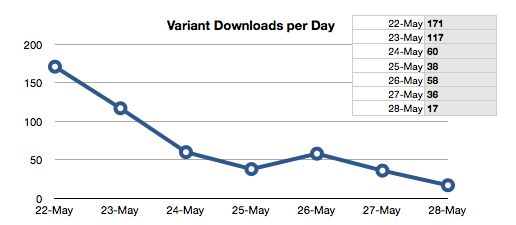My short story [The Variant](http://johnaugust.com/variant) has been on the market for a week. As promised, here’s an update on how the 99-cent experiment has gone.

Short version: I sold more copies than I expected, with fewer technical issues. I had picked the Friday of Memorial Day weekend precisely because I hoped it would be slower-paced, allowing me to fix whatever disasters struck without a crush of weekday traffic. But I could have been more ambitious, and a mid-week launch would have made more sense.
I get 35 cents on each Kindle sale, versus 89 cents on each download.
I’d be less grumbly about Amazon’s 65 percent cut if their reporting were better. Their DTP publisher tells you almost nothing about your sales. It only shows how many total units, with no breakdowns at all — not by day, not by state, nothing. Fortunately, I had embedded my Amazon tracking number in links from my site, so I do know that 458 of my Kindle sales came from people who clicked through from the launch page. That’s only a third of the Kindle sales, so many people were getting it in one of three alternate ways:
* Following a direct link from an outside site, such as [Daring Fireball](http://daringfireball.net/linked/2009/05/22/the-variant).
* Buying it through Kindle itself, either the device or the iPhone app. ((I have a hunch that a lot of readers tried out the iPhone app for the first time buying the book.))
* Finding the book on the Kindle bestseller list. ((I’ll have more to say about the bestseller list in another post.))
Downloads provide a lot more data. I’ve already written about the [international readers](http://johnaugust.com/archives/2009/mapping-the-variant), but the numbers also help show the falloff over time. It sold ten times more on the first day than the seventh.

(Note: I grabbed data at different times, so this total is 12 units shy of the table above.)
Today’s [NY Times article about The Variant](http://www.nytimes.com/2009/06/01/business/media/01august.html?ref=business) may provide a bump, but an esteemed colleague (Ze) cautions that he’s never seen a real spike from stories in traditional media.
At this point, I don’t have any big sense of What It All Means.
It’s a fine number of sales for a short story that would have likely been buried in some specialty magazine. But I’m not sure I can offer any meaningful analysis of the publishing model, partly because I started with a higher profile than many fiction writers might.
Could an established novelist duplicate (or exceed) these results? Probably. Could a talented but unknown upstart? Not as likely.
This kind of self-publishing certainly reduces the barriers, but literary brand recognition is still a huge asset. It is reading, after all. People would rather do almost anything than risk reading something bad. Free previews and a 99-cent price tag help, but the reputation of the author is likely a major factor in deciding to buy.